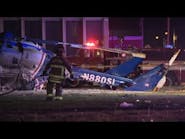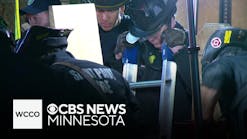Some of the damage was so bad that a few of the rigs were nearly unrecognizable. At least four rigs and a sedan were found several levels below the street when ground zero was being excavated.
Personnel from Fleet and Technical Services responded to the scene with supervisors, roadside mechanics, tow truck operators and fuel trucks. Initially, three teams consisting of a supervisor and two mechanics first located, then triaged the rigs. They determined if the rig was able to proceed or needed to be towed. If only minor repairs were needed, they were made. Approval to move the rigs was made after concerns about the crime scene were discussed. Two additional heavy wreckers from the Department of Environmental Protection were needed to help tow the large number of rigs. Many of the rigs were missing windshields, but still could be driven away. Apparatus damaged beyond repair were removed to the Staten Island Landfill. It took one week to remove all the rigs from the site.
The total apparatus destroyed included: 18 engines, seven rear-mounted aerial ladders, four tillered aerial ladders, four tower ladders, two rescues, two high-rise units, a tactical-support unit, three hazardous materials tenders, the technical response vehicle, a satellite hose wagon, a field communications van, a mask service truck, six ambulances, 16 Suburbans, 23 sedans and a Shops repair truck.
After an evaluation, rigs were decontaminated and cleaned inside and out. A supervisor and two mechanics followed a checklist to determine if repairs could be made immediately. Severely damaged rigs were stored. Those rigs that could be fixed quickly were brought into the huge FDNY repair shops. The shop personnel repaired 130 rigs during the first week following the terrorist attack. This ranged from windshields, warning lights and lenses to engines, pump overhaul and aerial ladder replacement. The apparatus were loaded with hose, ladders and fire tools. Every unit was back in service except first-due Engine 10 and Ladder 10.
The Shops staff worked 12-hour shifts, 24 hours a day, seven days a week. Many staffers refused to go home and slept in the shops so they could return to work and finish their assigned tasks. Local manufacturers' representatives, mechanics and dealers, retired members and mechanics from neighboring fire departments assisted in the herculean effort to restore the fleet.
The FDNY maintains a reserve fleet of 22 engines. Those engines were placed in service after the recall. All the apparatus from the Bureau of Training were taken to complement the spare fleet. The age and preventative maintenance of the spare fleet allowed better reliability than in the past. Future plans call for a potential reserve ladder fleet consisting of 10 apparatus, including rear-mount aerials and tower ladders.
Standardization played a key role in getting the fleet back in service so quickly. Windshields and cab and compartment doors are identical. Engines, transmissions, axles and brakes all contributed to getting the fleet in service in record time.
The FDNY received hundreds of offers from fire departments and manufacturers to supply replacement apparatus. Although extremely grateful, the FDNY decided to hold off and not accept apparatus that differed from FDNY specifications and requirements. One different piece of apparatus would help in the short-term, but would create long-term problems, such as training, parts and service.
To supply vehicles to battalions, divisions, EMS supervisors and other top officials, it was decided to acquire readily available vehicles. A total of 48 Chevrolet Yukons, Ford Excursions, Chevrolet Suburbans, Jeep Grand Cherokees and Ford Crown Victorias were either purchased or donated.
The Mayor's Office and the city comptroller declared an emergency, allowing Assistant Commissioner Thomas McDonald to order apparatus needed to put the fleet back to full strength. That day, $30 million in apparatus was ordered. To replace hose, firefighting hand tools, extrication equipment, air bags, power saws, rope, SCBA and cylinders, $8 million was spent.
Several manufacturers put on extra shifts to speed delivery of existing orders made prior to 9/11. Other manufacturers that the FDNY never dealt with before rushed to build units that the department could use.
A wide variety of support vehicles were purchased. These include vans, step vans, delivery trucks, flat-beds, rack trucks, mechanic's trucks, fork lifts, pickups, ATVs and wreckers.
Over a dozen cities, states, community groups or corporations provided monetary donations to replace apparatus or the actual donations of the apparatus itself.
The civilian and uniformed personnel met the challenge and performed better than anyone expected to bring the FDNY back to protecting the citizens of New York City.





